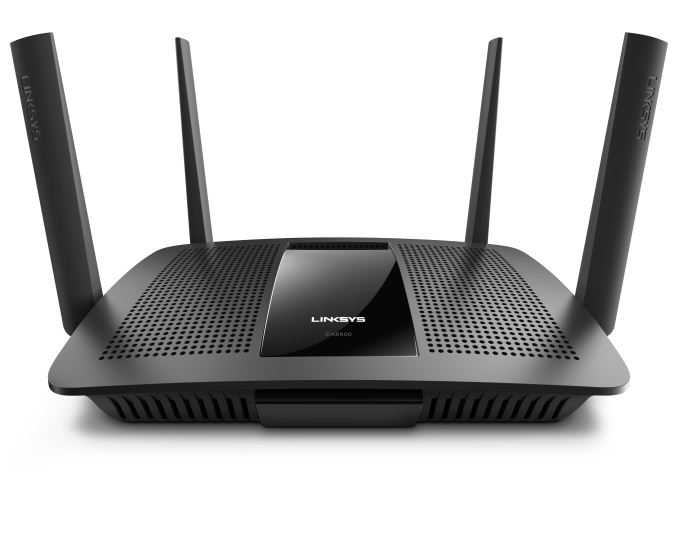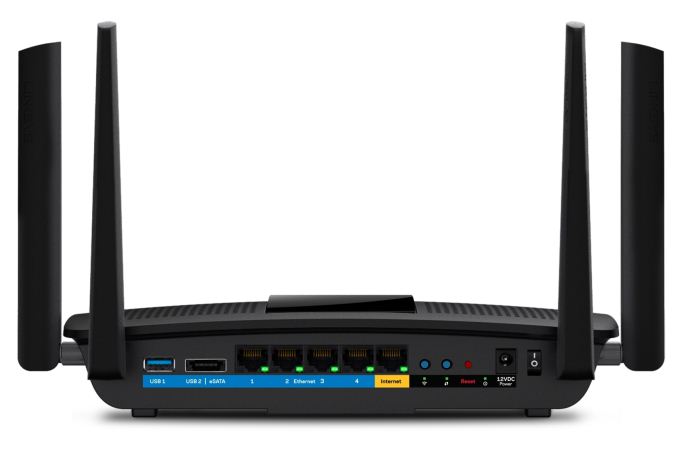Linksys EA8500 - First MU-MIMO Enabled 802.11ac Router Set to Ship
by Ganesh T S on May 7, 2015 7:00 AM EST- Posted in
- Networking
- Linksys
- 802.11ac
- Wi-Fi
- Qualcomm Atheros

Readers following our wireless networking coverage must be quite familiar with the developments in 802.11ac land. As a recap:
- The first 3-stream 802.11ac routers (based on the Broadcom BCM4706 chipset) started shipping in May 2012, with Buffalo Technologies and Netgear leading the way. There were marketed as AC1750 units (3x3 5 GHz providing up to 1300 Mbps and 3x3 2.4 GHz providing up to 450 Mbps). The street pricing of the AC1750 routers started to go down once Qualcomm started shipping their first-generation 802.11ac router platforms in products such as the TP-LINK Archer C7 in April 2013.
- In Q4 2013, a wave of AC1900 units started to hit the market. Netgear's Nighthawk R7000, a popular member in this series, still continues to sell well in the market. These units still used a 3x3 5 GHz radio for up to 1300 Mbps, but the 2.4 GHz had some proprietary Broadcom extensions (TurboQAM) to support up to 600 Mbps in an end-to-end Broadcom environment.
- In 2014, Quantenna began to bring their technology lead in the Wi-Fi space to the market with their Wave 2 4x4 802.11ac chipset. Despite being announced at CES 2014, the Asus RT-AC87U began to ship in July with the QSR1000 radio coupled with a Broadcom SoC. Netgear started to ship the same radio coupled with a Qualcomm IPQ8064 SoC in the Nighthawk X4 in September 2014. The QSR1000's Wave 2 feature set includes support for MU-MIMO, but neither of these routers shipped with MU-MIMO enabled in the firmware (citing lack of client support at that point of time). Given the 4x4 configuration, these routers were tagged as AC2350 / AC2400 units (600 Mbps in the 2.4 GHz band and 1733 Mbps in the 5 GHz band)
- In the midst of these Wave 2 product launches, Qualcomm announced plans for their Wave 2 802.11ac platforms (both routers and clients) in April 2014. Broadcom, being late to the Wave 2 party, decided to bring out the XStream platform with dual 5 GHz radios (six-stream configuration) also in April. They were able to get it quickly into the market too, with the Netgear Nighthawk X6 R8000 becoming available in June 2014.
- At CES 2015, we saw the first set of routers based on Qualcomm's QCA9880 4x4 Wave 2 802.11ac router platform getting announced. Vendors such as TP-LINK and TRENDnet were expecting their AC2600 class routers to ship towards the middle of the year.
Coming back to today's announcement regarding the EA8500, Linksys is becoming the first vendor to start shipping a QCA9980-based router. The important aspect here is that the router will ship with MU-MIMO enabled. Client devices with MU-MIMO enabled are also coming into the market just now (more on that in our detailed review). Hopefully, this announcement will spur both Netgear and Asus to enable MU-MIMO in the firmware for their Quantenna-based routers.
The salient features of the EA8500 router are listed below:
- 4x4 802.11ac with MU-MIMO and beamforming support
- QCA9980 radio + 1.4 GHz dual-core IPQ8064 SoC
- Simultaneous dual-band operation (5 GHz 802.11ac - 1733 Mbps, 5 GHz 802.11n - 600 Mbps, 2.4 GHz 802.11n - 800 Mbps)
- 1x USB 3.0, 1x USB 2.0 / eSATA
- 4x 1Gbps LAN, 1x 1Gbps WAN
- Adjustable antennas for optimal performance
One important point to note is that MU-MIMO capabilities will translate into real benefit only when there are multiple MU-MIMO-capable client devices talking to the router simultaneously. This will probably be a common scenario in enterprise Wi-Fi deployments soon. However, in a typical household, we would imagine that a situation involving multiple MU-MIMO clients is probably at least a good year away. Qualcomm is targeting an end-to-end play here, as the announcement made last year included a number of products in the client space with MU-MIMO capabilities.
Linksys is accepting pre-orders at $280 for the EA8500 today with shipments slated for May 10, 2015. Wide retail and e-tail availability is also expected starting next week. There is no doubt that MU-MIMO will be the most efficient way to boost Wi-Fi performance in the near future, and it is good that Linksys and Qualcomm are teaming together to accelerate its market adoption.
Source: Linksys











83 Comments
View All Comments
UtilityMax - Tuesday, May 12, 2015 - link
Linksys is not going to lose its sleep over a couple of nerds on anandtech who may _think_ they would _possibly_ need a 10Gbit WAN port at the time when 1gigabit remains an unattainable luxury to most households. Even if 2Gbps broadband becomes available all over the country next year as some ISP promise, I don't see households tripping over each other trying to get that service. What's that bandwidth for? A 4k video streaming needs what, 20-50Mbps of bandwidth. So a 1Gbps WAN connection will give you more than a dozen 4k streams already. I can see most people certainly wanting 100Mbps broadband, and many willing to pay a small premium for 1Gbps, but ISPs will have a hard time building a case for mass adoption of even 2Gbps broadband unless it cost a 5-10 buck premium over 1Gbps.And, I am sure there may be some kind of premium product in the works right now with 10Gbps ports, but this router I am sure will be sold for $199 on amazon a year from now. The key signature of this product is MU-MIMO wireless-ac networking, which will become more commonplace faster than even gigabit broadband.
Lucky Stripes 99 - Wednesday, May 13, 2015 - link
Your second response is confusing. You're arguing against the merits of 10GbE on the WAN (untrusted) side, yet my previous post advocated for 10GbE on the LAN (trusted) side, preferably using a SFP+ port. I did advocate for a SFP port on the WAN side, but SFP ports only support 1GbE GBIC modules.Why do you keep thinking that I want 10GbE on the WAN side? I don't.
joeymore - Saturday, November 7, 2015 - link
If you already have an existing router but are not happy with its range, check http://www.consumerrunner.com/top-10-best-routers/ and see how you extend network range wirelessly!